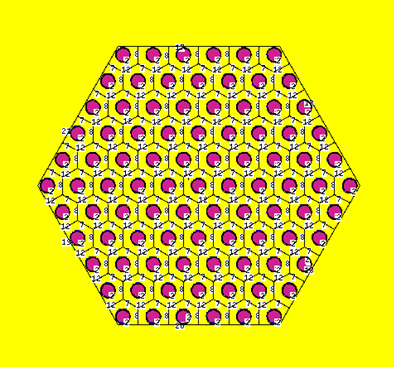The team looked at four requirements for the RUSE: It must be safe, educational, cost effective, and small enough to fit on campus. The RUSE is designed to have a maximum multiplication factor of 0.9 to keep a relatively large margin between operating multiplication factor and criticality. The RUSE was also designed around different student laboratories. The team picked 10 labs in order to replicate the current Critical Reactor Laboratory course structure. The RUSE is designed as a pool-type reactor with a hexagonal pitch structure for the reused RCF fuel pins. This allows the RUSE to obtain its maximum effective neutron multiplication factor, keff = 0.9, with the fewest number of pins in a small geometry. The RUSE can use two different neutron sources: a PuBe neutron source for experiments requiring a steady flow of neutrons and a DT neutron source for pulsed neutron experiments. This allows for a wider variety of laboratories to be conducted at the RUSE.
Team: Ryan Durac, Katie McFadden, Carly Blaugher, and Alec Casillo
Project Motivation
The RUSE is a subcritical reactor to be built for RPI’s Troy Campus as a replacement for RPI’s current research reactor, the Walthousen Reactor Critical Facility (RCF). Among other uses, the RCF is used to teach an invaluable undergraduate course, the Critical Reactor Laboratory. The goal of the RUSE is to allow undergraduate students the opportunity to take a hands on, practical course that demonstrates the concepts learned in classes such as Physics of Nuclear Reactors and Nuclear Instrumentation and Measurement in the event that the RCF is decommissioned.

A top down view of the RUSE core with the fuel in pink, the cladding in black, and the moderator in yellow.
Project Description
The team looked at four requirements for the RUSE: It must be safe, educational, cost effective, and small enough to fit on campus. The RUSE is designed to have a maximum multiplication factor of 0.9 to keep a relatively large margin between operating multiplication factor and criticality. The RUSE was also designed around different student laboratories. The team picked 10 labs in order to replicate the current Critical Reactor Laboratory course structure. The RUSE is designed as a pool-type reactor with a hexagonal pitch structure for the reused RCF fuel pins. This allows the RUSE to obtain its maximum effective neutron multiplication factor, keff = 0.9, with the fewest number of pins in a small geometry. The RUSE can use two different neutron sources: a PuBe neutron source for experiments requiring a steady flow of neutrons and a DT neutron source for pulsed neutron experiments. This allows for a wider variety of laboratories to be conducted at the RUSE.
Results and Accomplishments
The RUSE is a pool type reactor with 127 fuel pins arranged in a hexagonal-pitched lattice to minimize the number of fuel pins used to reach keff = 0.9 with water as the moderator. The RUSE uses a PuBe source for all laboratories and experiments requiring a steady neutron source and a DT Fusion source for laboratories requiring a pulsed neutron source. There are 10 laboratories designed to be run on the RUSE to provide an replacement course for all undergraduates who would otherwise be enrolled in Critical Reactor Laboratory. Through the use of MCNP, the RUSE was able to be designed within the design constraints, and may potentially act as a competent replacement to the RCF.